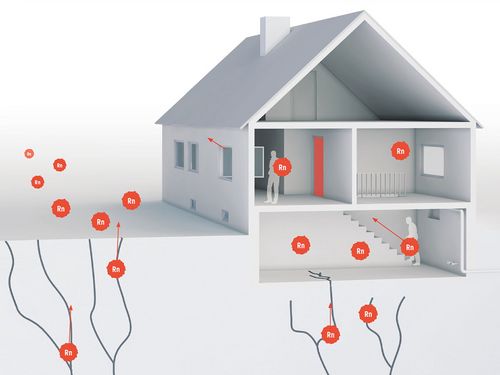The joint sheet PENTAFLEX KB® 167 and KUNEX® joint tapes from 5.5 mm material thickness of the PohlCon brand H-BAU Technik have been proven to protect against the radioactive gas radon. Now an external testing institute has confirmed that our pre-applied fully bonded waterproofing system SECUFLEX® is also radon-proof.
As early as the Middle Ages, a mysterious lung disease was rampant among miners in the region around the town of Schneeberg in the Ore Mountains: the so-called Schneeberg disease. Even at a young age, miners suffered from coughing, bloody sputum and shortness of breath. It was not until the beginning of the 20th century that the cause of this particular form of lung cancer was identified: The miners had inhaled radioactive dust and gas – radon.
Radon – a little-known risk
Outside of mining regions, radon is a problem little known to the public. The radioactive natural gas is produced by the natural decay of uranium, which occurs regionally more or less in the depths of the earth. Radon penetrates to the surface through cracks in the rock and also enters cellars and interiors via inadequately sealed buildings, for example through joints between cellar walls and foundations or via cable shafts, pipes and cracks in walls.
Radon decays into the radioactive by-products polonium, bismuth and lead, which attach themselves to the finest particles in the air and are inhaled. They decay in the lungs and emit alpha radiation – this damages the tissue and causes lung cancer.
Special requirements in precautionary areas
Radon radiation exposure is low outdoors because the gas disperses quickly. In unventilated rooms, however, especially those close to the earth, it can accumulate strongly: a danger that can neither be seen nor smelled nor tasted.
According to the Radiation Protection Act, since January 2021, special requirements for protection against radon apply specifically to so-called precautionary areas – severely affected regions such as former mining areas in Saxony and Thuringia with indoor radon concentrations of more than 300 becquerels per cubic metre. But elevated levels can also occur in other areas. Therefore, protection against radon should be considered as a matter of principle when planning new buildings.
Prevention and aftercare
In endangered existing buildings, it is recommended to ventilate basement rooms and seal doors and pipes to the basement or cracks and joints in the basement. Extracting radon-containing soil air from under the building is also an option.
In new buildings, a so-called white tank made of water-impermeable reinforced concrete protects against both soil moisture and the radioactive gas. PohlCon's radon-proof joint sheets and tapes can be used to seal the joints. In order to also reliably seal unplanned separation cracks or faults against radon, the use of the SECUFLEX® pre-applied fully bonded waterproofing system is recommended as an additional measure, the radon-proofing of which has now also been confirmed by an independent body.
